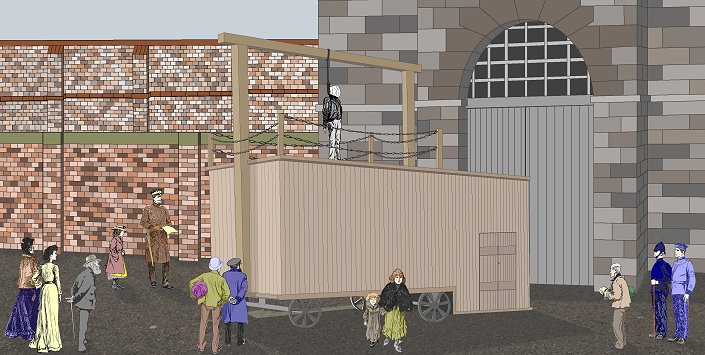|
The
Execution of John Duffield
From the time of receiving sentence, not the least hope
could be entertained of a reprieve for Duffield, though
the Rev. Mr. Lowe, Rector of Darlaston, humanely
followed the Judge to Shrewsbury, hoping to obtain a
mitigation of punishment. Duffield being assiduously
attended by the Rev. Mr. Knight, the Chaplain to the
gaol, his mind soon became calm, and he appeared to meet
his doom without emotion; his time being mostly employed
in imploring mercy from his offended maker.
On
the Wednesday before he suffered, his wife paid him a
visit, attended by another relative, and the Rev. Mr.
Lowe – the scene was truly affecting. Two other friends
visited him on Friday. The day and night previous to the
execution were spent most devoutly, and on being asked
how he felt himself, he said, “God has been very good to
me; nothing gives me uneasiness, only that I have not
brought up my children as I ought to do – in the fear of
the Lord.” The fears that he expressed about his
children were fully justified by his son James, who was
also sentenced to death only some six months after his
father, as further detailed below.
Executions at this time took place in public. At
Stafford they had until 1817 been carried out on the
roof of the Gatehouse. The gate-house to Stafford Gaol
stood on Gaol Road and contained the reception ward and
a room for the warders. The roof of the gate-house was
used as the place of execution until 1817. The lower
outer wall was to prevent ladders being placed at the
foot of the inner wall, whose ornate top layer of
brickwork was loose, designed to collapse should anyone
try to climb over. The gate-house was demolished in 1952
in order to widen Gaol Road.
On
21st March, 1817, Ann Statham became the last prisoner
to be hanged there. Ann, a single mother, had murdered
her infant daughter. Many sources report that as she
knelt in prayer on the platform, the scaffold gave way
and Ann, the Chaplain and other officers all fell to the
roof below. The scaffold had to be re-assembled so that
the execution could take place. This dramatic account is
disputed by some, but the fact remains that from this
time on, executions were performed on portable gallows
that were wheeled out to the front of the Gaol as
required. John Duffield was only the fourth person to be
executed on this portable gallows. |

Figure 6.
Portable Gallows at Stafford Jail. Courtesy of Bev Parker.
On Saturday 21st
August, 1819 at about six o’clock in the morning,
service commenced in the chapel, which, with the
administration of the holy sacrament, occupied the
time till near eight, when the tolling of the bell
announced the approach of the unfortunate criminal.
A hurdle (traditionally a kind of rough sled similar
to a piece of fencing made from thin branches
interwoven to form a panel, to which the prisoner was
tied, to be dragged behind a horse) being prepared,
he was drawn to the door of the Lodge. A
contemporary account of an execution at another gaol
describes how a hurdle, painted black, with seats in
each side was waiting to convey the prisoners to the
scaffold and they were drawn along by a horse to the
foot of the scaffold.
On reaching the
foot of the ladder, a moment’s delay ensued, when
Duffield spoke with great composure, saying, “I am
going to Heaven.” He ascended the platform with a
steady step, and while the executioner was adjusting
the rope, did not show the least agitation. After
spending about five minutes in fervent prayer, the
signal was given, the drop fell, and he died almost
without a struggle. When cut down, his body was
given to his friends, who conveyed it to Darlaston
(a distance of some nineteen miles) for interment
the same day.
The
Wolverhampton Chronicle of 25th August, 1819
reported that: "On Saturday morning, about half-past
eight o’clock, John Duffield underwent the awful
sentence of the law at the front of the county gaol
at Stafford, for counterfeiting, at Darlaston, the
coin of this realm called a shilling, of which he
was convicted (with Josiah Wilkes and Thos. Earp) at
our late assizes."
Newspapers report
that he was 47 years of age, and left seven
children. The Parish Registers of Darlaston show
that John Duffield of Cramphill Bank, aged 46,
executed at Stafford for coining, was buried at
Darlaston on 21st August, 1819, Rector S. Lowe
officiating.
|
 |
|
 |
|
 |
|
Return to John Duffield's trial |
|
Return to
the beginning |
|
Proceed to
Wilkes and Earp |
|